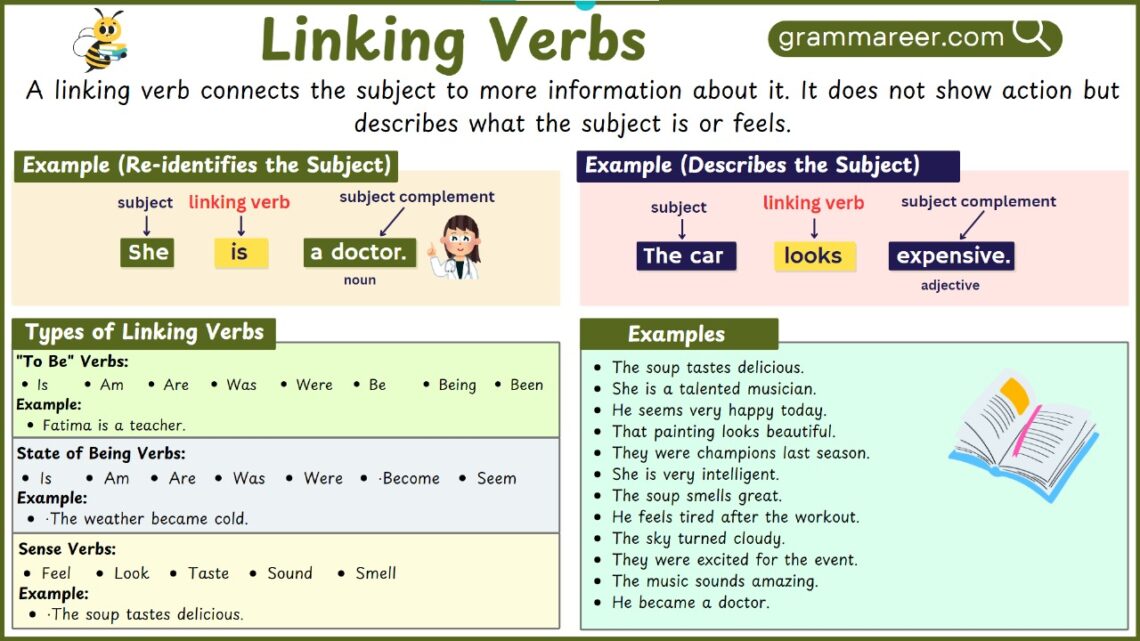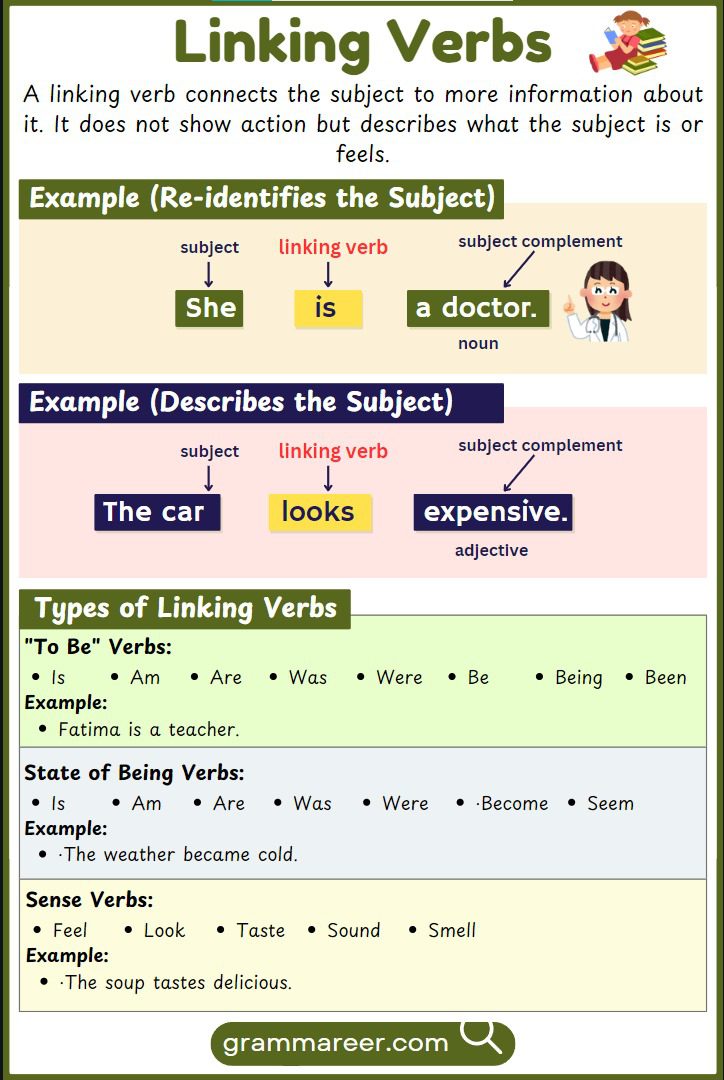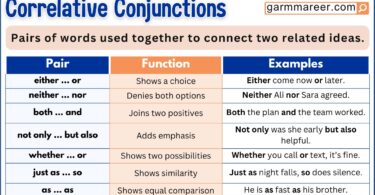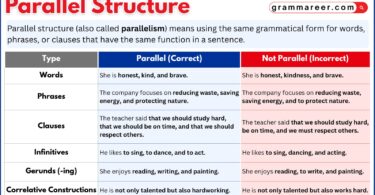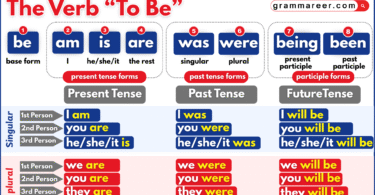Linking verbs are important in English grammar because they help connect the subject of a sentence to more information without showing an action. Common linking verbs helps you make clear and descriptive sentences about the subject’s condition or identity.
Example:
- Sara is tired.
In this sentence, the word “is” is a linking verb because it connects the subject “Sara” to the word “tired.” It doesn’t show action; it just links Sara to more information about how she feels.
Table of Contents
Types of Linking Verbs
Linking verbs can be grouped into different types based on what they do. Let’s look at some common types of linking verbs:
1. “To Be” Verbs
The most common linking verbs are forms of the verb “to be.” These include:
- Am
- Is
- Are
- Was
- Were
- Be
- Being
- Been
These verbs connect the subject to more details about its identity or state.
Example:
- Tom is a doctor.
Here, “is” links the subject “Tom” to his job, “doctor.”
2. State of Being Verbs
State of being verbs describe the subject by linking it to a state or condition. These verbs include:
- Become
- Seem
- Remain
- Stay
- Appear
These verbs show the condition or state of the subject.
Examples:
- The leaves became yellow. (“Became” links “leaves” to their condition “yellow.”)
- She seems upset. (“Seems” links “she” to “upset.”)
3. Sense Verbs
Sense verbs link the subject to experiences perceived through the senses. These verbs include:
- Feel
- Look
- Taste
- Sound
- Smell
Example:
- The cake smells wonderful.
In this sentence, “smells” links “cake” to the description “wonderful.”
List of Linking Verbs
Here is a list of common linking verbs:
- “To Be” Verbs: am, is, are, was, were, be, being, been
- Sense Verbs: look, taste, feel, smell, sound
- State of Being Verbs: become, seem, remain, stay, appear
Linking Verb Examples in Sentences
To help understand linking verbs better, here are some examples:
- The soup tastes delicious.
- She is an excellent dancer.
- He seems quite nervous.
- The sky looks beautiful.
- They were the leaders of the group.
Linking Verb Examples in Different Tenses
Present Tense Examples
They tell us about the present include “is,” “am,” and “are.”
Examples:
- They are joyful.
- The food tastes great.
- She is feeling relaxed.
- The children are excited.
They help describe how something or someone feels right now.
Past Tense Examples
The verbs like “was” and “were” tell us about the past.
Examples:
- He was a musician.
- They were exhausted after the trip.
- The performance was amazing.
- She was cheerful last night.
These words show how things were in the past.
Future Tense Examples
“Will be” is used to talk about the future.
Examples:
- They will be successful.
- The show will be entertaining.
- He will be an excellent coach.
- The meal will taste fantastic.
These verbs show how things will be in the future.
How to Identify Linking Verbs?
Identifying linking verbs can sometimes be tricky. Here are some tips to help you:
1. Substitution Test
Try replacing the verb with a form of “to be” (am, is, are, was, were). If the sentence still makes sense, the verb is likely a linking verb.
Example:
- Maya looked happy.
If we replace “looked” with “is”: Maya is happy. This makes sense, so “looked” is a linking verb.
2. Check for Complements
If the verb links the subject to a word that describes it (like an adjective or noun), it is a linking verb.
Example:
- The flowers smell fresh. (“Smells” links “flowers” to “fresh.”)
Linking Verb Rules
1. No Action
They do not describe an action. They just connect the subject to more information.
Correct: Lily is calm.
Incorrect: Lily is running calm.
2. Subject Complement
They are always followed by a complement, which is a word that gives more information about the subject. This can be a noun, pronoun, or adjective.
Correct: Omar became an engineer.
Incorrect: Omar became quickly.
The correct sentence gives us more information about Omar (“an engineer”). The incorrect sentence does not have a proper complement.
Linking Verbs vs. Action Verbs
Linking verbs and action verbs have different functions. Linking verbs describe the subject, while action verbs show what the subject is doing.
Linking Verbs
Linking verbs connect the subject to more information about it. They describe a state of being, not an action.
Examples:
- The kitten is playful. (“Is” links “kitten” to “playful.”)
- She appears calm. (“Appears” links “she” to “calm.”)
Action Verbs
Action verbs show what the subject is doing, either physically or mentally.
Examples:
- The dog jumps high. (“Jumps” shows the action of the dog.)
- He studies every night. (“Studies” shows what he is doing mentally.)
Common Mistakes
Even though linking verbs are simple to understand, people often make mistakes when using them. Here are some common mistakes to watch out for:
1. Using an Action Verb Instead of a Linking Verb
Sometimes, people use an action verb when they actually need a linking verb.
Incorrect: She feels the cat. (This sentence shows an action.)
Correct: She feels tired. (In this sentence, “feels” is a linking verb connecting “she” to “tired.”)
2. Using a Linking Verb with an Incorrect Complement
Linking verbs need a complement that describes the subject. If you use an adverb instead, it will be incorrect.
Incorrect: He seems happily.
Correct: He seems happy. (Here, “happy” is an adjective that describes “he.”)
3. Adding Extra Words After a Linking Verb
Sometimes, people add extra words that aren’t necessary after a linking verb.
Incorrect: The soup tastes like delicious.
Correct: The soup tastes delicious. (The word “like” is unnecessary here.)
Summary
Linking verbs are important in English grammar because they help connect the subject of a sentence to more information without showing an action. Common linking verbs helps you make clear and descriptive sentences about the subject’s condition or identity.
Read More

